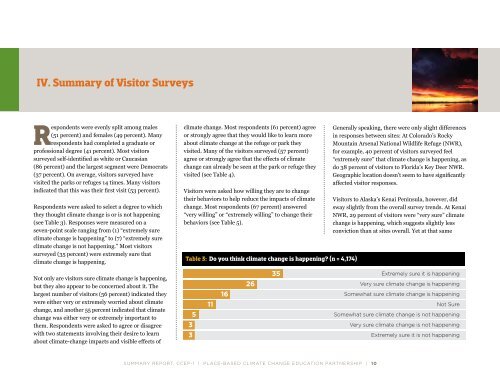Place-based Climate Change Education Partnership Report.pdf
Place-based Climate Change Education Partnership Report.pdf
Place-based Climate Change Education Partnership Report.pdf
Create successful ePaper yourself
Turn your PDF publications into a flip-book with our unique Google optimized e-Paper software.
IV. Summary of Visitor Surveys<br />
Respondents were evenly split among males<br />
(51 percent) and females (49 percent). Many<br />
respondents had completed a graduate or<br />
professional degree (41 percent). Most visitors<br />
surveyed self-identified as white or Caucasian<br />
(86 percent) and the largest segment were Democrats<br />
(37 percent). On average, visitors surveyed have<br />
visited the parks or refuges 14 times. Many visitors<br />
indicated that this was their first visit (53 percent).<br />
Respondents were asked to select a degree to which<br />
they thought climate change is or is not happening<br />
(see Table 3). Responses were measured on a<br />
seven-point scale ranging from (1) “extremely sure<br />
climate change is happening” to (7) “extremely sure<br />
climate change is not happening.” Most visitors<br />
surveyed (35 percent) were extremely sure that<br />
climate change is happening.<br />
climate change. Most respondents (61 percent) agree<br />
or strongly agree that they would like to learn more<br />
about climate change at the refuge or park they<br />
visited. Many of the visitors surveyed (57 percent)<br />
agree or strongly agree that the effects of climate<br />
change can already be seen at the park or refuge they<br />
visited (see Table 4).<br />
Visitors were asked how willing they are to change<br />
their behaviors to help reduce the impacts of climate<br />
change. Most respondents (67 percent) answered<br />
“very willing” or “extremely willing” to change their<br />
behaviors (see Table 5).<br />
Table 3: Do you think climate change is happening? (n = 4,174)<br />
Generally speaking, there were only slight differences<br />
in responses between sites: At Colorado’s Rocky<br />
Mountain Arsenal National Wildlife Refuge (NWR),<br />
for example, 40 percent of visitors surveyed feel<br />
“extremely sure” that climate change is happening, as<br />
do 38 percent of visitors to Florida’s Key Deer NWR.<br />
Geographic location doesn’t seem to have significantly<br />
affected visitor responses.<br />
Visitors to Alaska’s Kenai Peninsula, however, did<br />
sway slightly from the overall survey trends. At Kenai<br />
NWR, 29 percent of visitors were “very sure” climate<br />
change is happening, which suggests slightly less<br />
conviction than at sites overall. Yet at that same<br />
Not only are visitors sure climate change is happening,<br />
but they also appear to be concerned about it. The<br />
largest number of visitors (56 percent) indicated they<br />
were either very or extremely worried about climate<br />
change, and another 55 percent indicated that climate<br />
change was either very or extremely important to<br />
them. Respondents were asked to agree or disagree<br />
with two statements involving their desire to learn<br />
about climate-change impacts and visible effects of











